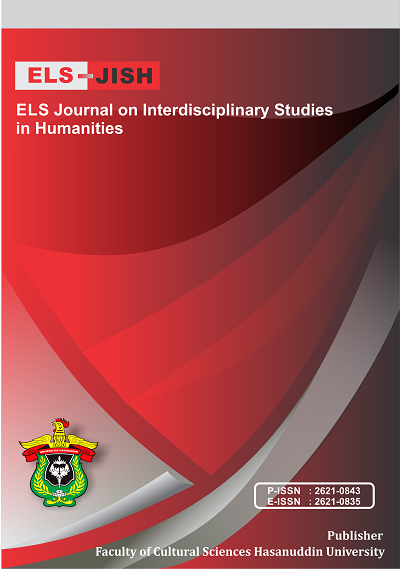“Sleep” Subtype of Rest Verbs in English and Buginese: Dixon’s Theoritical Framework
DOI:
https://doi.org/10.34050/elsjish.v5i4.24818Keywords:
Buginese, Dixon’s Theory, English, Sleep Verb, Rest VerbsAbstract
The aims of this research are (1) To identify rest verbs in English and Buginese based on Dixon's classification of sleep subtypes. (2) To examine the distinctions and equivalences between the English and Buginese Sit subtypes of Rest verbs in terms of semantics and grammatical structure. While the data for Buginese were gained from field research through the process of observation and in-depth interview, the data for English were taken from the Corpus of Contemporary American English (COCA). Both sets of data were evaluated using qualitative and descriptive methods. This study's findings demonstrate that (1) there are six rest verbs of Sleep subtype in English, they are sleep, nap, doze, siesta, drowse, catnap, and beauty sleep. While in Buginese, there are many verbs that refers to rest verb, they are Tinro’, lewu’, makkapeddeng’,cakkaruddu’, mappalempu’, moppang’, lengeng’, nDitti’, manippi’, mappasau’ tengngeng’, maggalelu’ mangkangulu’, makkadukku’, maggalengkeng’, mappalangka’, mabboco’, ma’ranjang, maggalampang’, rebba’-rebba’, lesso’, mammauneng’, mangoro’and mabbenni’. (2) Clause structure and stance of resting are two areas where the main distinctions between rest verbs in English and Buginese based on the Sleep subtype may be recognized. According to clause structure, an NP in English is followed by a VP, however in Buginese it is acceptable for a VP to be followed by an NP that is denoted by the prefix Ma'- in VP. From the perspective of the resting aspect, cultural background has a significant impact on the different rest verb forms. Keywords: Preposition, locus, culture, rest verbs, semantic verb kinds.
References
Andini, C., Yassi, A.H., & Sukmawaty. (2021). The Use of Honorifics in English and Buginese with special Reference to Bone Language: A Comparative Study. International Journal of Innovative Science and Research Technology, 6(7), 873-877.
Dixon R M W. (2005). A Semantic Approach to English Grammar.Second Edition. New York: Oxford University Press.
Ba’dulu, Abdul Muis (2009). Introduction To Linguistics. Makassar: Universitas Negeri Makassar.
Bachriani, B., Yassi, A. H., & Rahman, F. (2018). A Comparative Study of Euphemism in English and Buginese: Pragmatic Stylistics Contexts. ELS Journal on Interdisciplinary Studies in Humanities, 1(4), 429-440.
Pelras, Christian. (1996). The Bugis. Oxford: Blackwell Publisher Ltd.
Rahmaniar (2022). English Verb “Catch” and Its Related Verbs in Buginese Language: A Comparative Study. A Journal.
Sukmawaty, S., Andini, C., & Rahman, F. F. (2022). The Shift of Honorifics due to The Promotion as A Government Official: Comparative Study. ELS Journal on Interdisciplinary Studies in Humanities, 5(1), 166-176.
Fadhilah, Nurul (2022). The Break Subtype of Affect-H in English and Buginese: Revisiting Dixon’s Theoretical Framework.
Hartari, A.Reskiana. (2008). Dixon’s Sit Subtype of Rest Verbs in English and Buginese
Daud, N (2018). The Politeness Strategies of Negation Used by English and Buginese.
Colle, Andi Tenry Lawangen Aspat (2020), A Contrastive Analysis of English and Buginese Declarative Sentences Pattern.
Tahir, D., Rahman, F., & Rahman, A. (2018). The Study of Buginese Reciprocal Verb in the Boegineesche Chrestomathies Manuscript. Am. J. Humanit. Soc. Sci. Res, 2(08), 48-54.
Downloads
Published
How to Cite
Issue
Section
License
Copyright (c) 2022 Wahyuningsi Fahrah, Abdul Hakim Yassi, Sukmawaty Sukmawaty

This work is licensed under a Creative Commons Attribution-NonCommercial-ShareAlike 4.0 International License.






